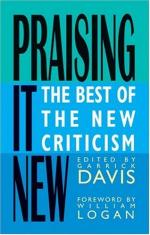|
This section contains 7,587 words (approx. 26 pages at 300 words per page) |

|
SOURCE: Willingham, John R. “The New Criticism: Then and Now.” In Contemporary Literary Theory, G. Douglas Atkins and Laura Morrow, pp. 24-41. Amherst: University of Massachusetts Press, 1989.
In the following essay, Willingham follows the development of New Criticism from its earliest proponents in the 1930s to the later 1900s, detailing the evolution of the theory from its early days to the present, and offering a summary of the place New Criticism holds in modern literary studies.
The term formalism, broad if not ambiguous, refers to the many critical dogmas and related “practical criticism” that accompanied the sea change from Anglo-American romanticism to the modernist avant-garde. Typically, formalism asserts the autonomy of the artifact, the preeminence of form and style over relationships of the work to “life,” and the irrelevance of older doctrines like mimesis or any idea that poetry's highest value is its reflection of the “real world...
|
This section contains 7,587 words (approx. 26 pages at 300 words per page) |

|


